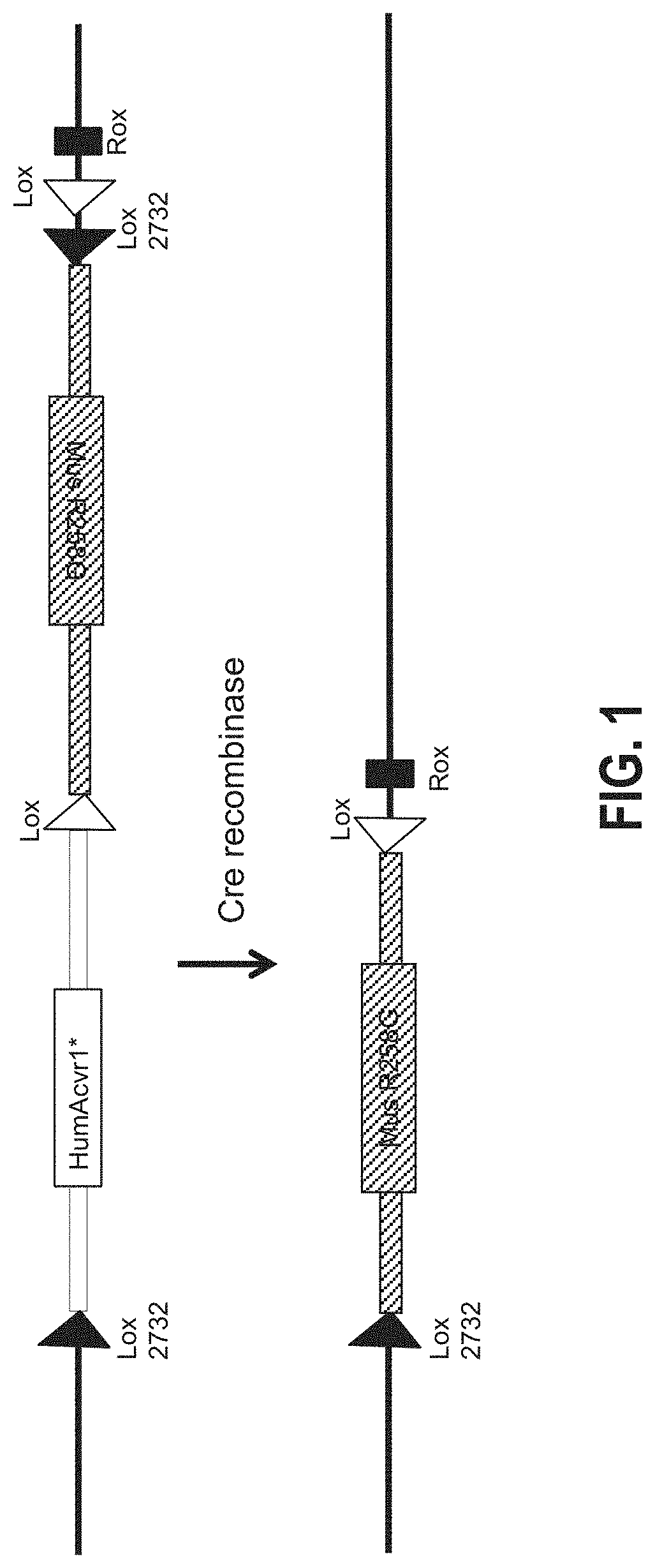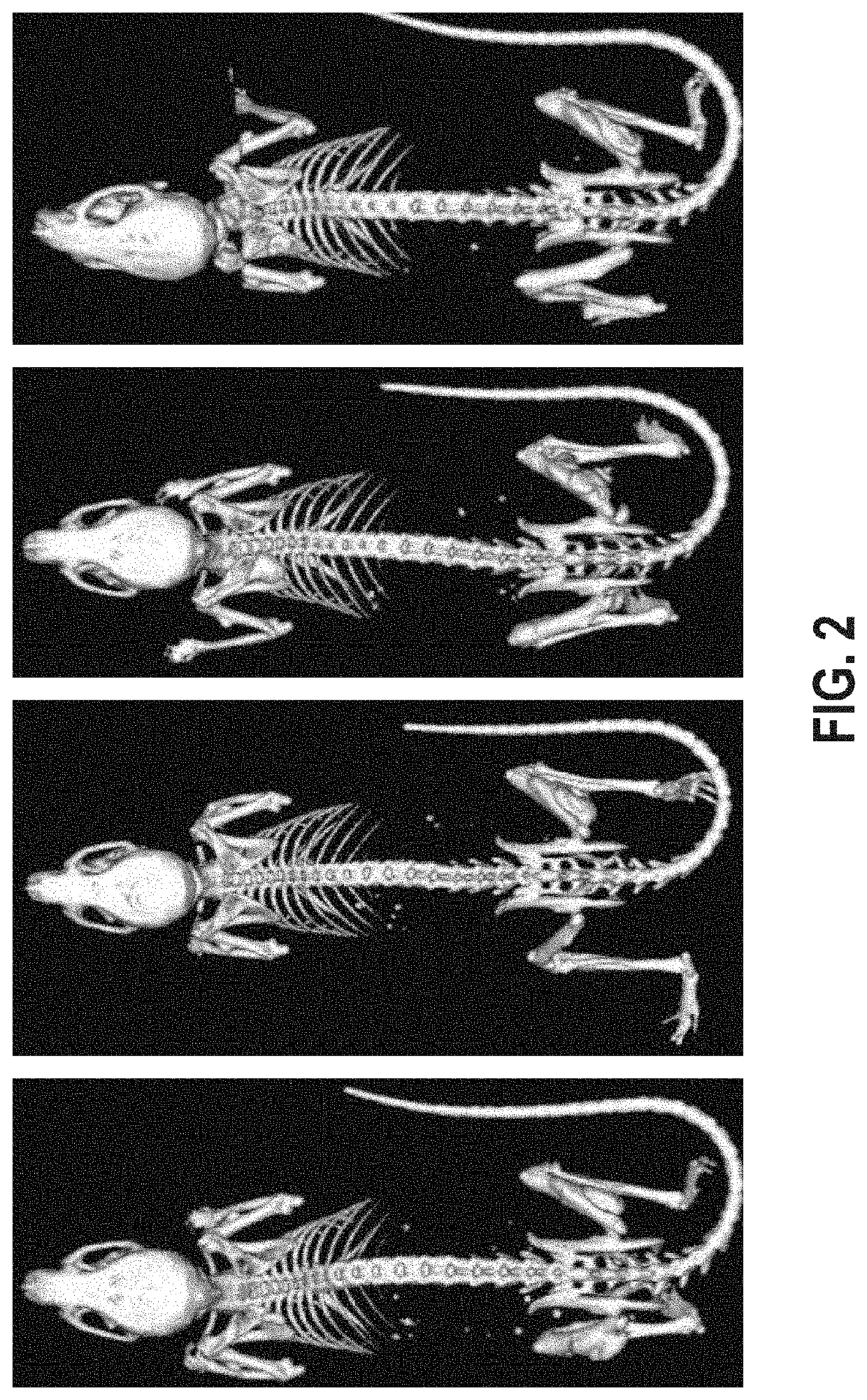Rodent model of fibrodysplasia ossificans progressiva
a technology of fibrodysplasia and rodent models, applied in the field of genetically modified rodents, to achieve the effect of facilitating identification and selection of correctly targeted clones
- Summary
- Abstract
- Description
- Claims
- Application Information
AI Technical Summary
Benefits of technology
Problems solved by technology
Method used
Image
Examples
example 1
[0100]The region bounded by nucleotides 58468399 to 58468770 in mmuAcvr1 (i.e., nucleotides 58468399 to 58468770 of mouse Chromosome 2, GRCm38 / mm 10) was replaced with a nucleic acid composed of nucleotides 157770252 to 157770625 of hsaACVR1 (i.e., nucleotides 157770252 to 157770625 of human Chromosome 2, GRCh38 / hg38), in a manner such that the introduced sequence, which includes hsaACVR1 exon ENSE00001009617, was transcribed as part of the resulting modified Acvr1[R258G]F1Ex locus. In addition, by altering codon choice, the nucleotide sequence of human exon ENSE00001009617 was altered to reduce sequence identity between the mouse and human exon, without altering protein coding. This introduced human sequence is referred to hereafter as hsa_e7+. Therefore, prior to inversion of the F1Ex element (altered exon ENSMUSE00001232449 and associated upstream and downstream intronic sequences-see below), the resulting locus, Acvr1[R258G]F1Ex, should function as wild type.
[0101]The R258G vari...
example 2
[0107]Inducing FOP in Acvr1[R258G]F1Ex mice
[0108]To enable time-controlled yet whole body inversion of the Acvr1[R258G]F1Ex allele, Acvr1[R258G]F1Ex mice were mated with Gt(ROSA26)SorCreERT2 / + mice to generate Acvr1[R258G]F1Ex; Gt(ROSA26)SorCreERT2 / +. These were maintained in heterozygosity on a mixed—C57BL / 6NTac-129S6 / SvEvTac background. All experiments were performed in accordance with the Institutional Animal Care and Use Committee of Regeneron. Both male and female mice were used between 8 and 11 weeks of age, however mice were aged and sex matched between groups. No age or sex related phenotypes were noted. The model was initiated by inversion of the R258G-encoding exon into the sense strand, which was accomplished by treating Acvr1[R258G]F1Ex; Gt(ROSA26)SorCreERT2 / + mice with 40 mg / kg of tamoxifen (Sigma) in oil intraperitoneally (i.p.) daily for 5 days (to activate CreERT). To assess heterotopic bone formation, mice were anesthetized by isofluorane and whole body-scanned, wit...
PUM
 Login to View More
Login to View More Abstract
Description
Claims
Application Information
 Login to View More
Login to View More - R&D
- Intellectual Property
- Life Sciences
- Materials
- Tech Scout
- Unparalleled Data Quality
- Higher Quality Content
- 60% Fewer Hallucinations
Browse by: Latest US Patents, China's latest patents, Technical Efficacy Thesaurus, Application Domain, Technology Topic, Popular Technical Reports.
© 2025 PatSnap. All rights reserved.Legal|Privacy policy|Modern Slavery Act Transparency Statement|Sitemap|About US| Contact US: help@patsnap.com



